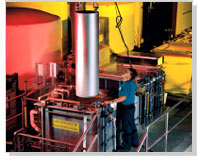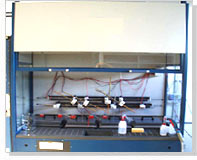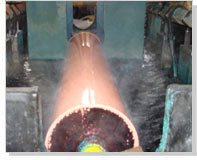 Metal plating is a technique used to favorably change the surface properties of a metal by adding some sort of metal coating to the part. Nowadays, plating has become a general name for surface-covering techniques, wherein a a metal is deposited onto a conductive surface.
Metal plating is a technique used to favorably change the surface properties of a metal by adding some sort of metal coating to the part. Nowadays, plating has become a general name for surface-covering techniques, wherein a a metal is deposited onto a conductive surface.
Metal plating is essential as a corrosion inhibitor for the manufacturing of mobile phones, computers and electronic devices as well as other uses such as solderability, hardness, wearability, paint adhesion, friction loss, shielding, conductivity, etc. Moreover, it has emerged as a key technology for the design and development of new machines.
Plating is also used for decoration purposes, such as in jewelry to provide a gold or silver exterior. Thin-film deposition techniques have executed plating on scales as small as the width of an atom, so it is suitable to call some plating applications nanotechnology.
There are different processes of metal plating. For example, in one process, a solid surface is covered with a sheet of metal, and then heat and pressure are applied to fuse them together. Some other plating methods include vapor deposition under vacuum, sputter deposition, and methods using gas or vacuum conditions. In recent times, however, only the plating techniques that use liquid tend to be referred as "plating". Metallizing is referred as the technique of coating metal on non-metallic objects.
Metal plating processes involve the application of predominantly inorganic coatings onto surfaces to furnish hardness, corrosion resistance, wear resistance, anti-frictional characteristics, electrical or thermal conductivity, or decoration. The method typically uses an electrical (anode/cathode) relationship between the plating bath and workpiece. Some common forms of metal plating are -
- Barrel plating that plates several small parts at one time. Components in a workload are tumbled in a cascading action by a revolving vessel or "barrel" immersed in a plating bath.
- Brush plating takes the plating solution to the workpiece surface by an absorbent covering wrapped about a hand-held stylus, working as the anode. The workpiece operates as the cathode and the process is driven by a direct current power pack.
- Electroless plating simply occurs through the immersion of parts in a plating bath.
- Electroplating is one of the most common methods at finishing shops. In this method, metal ions in either alkaline, acidic or neutral solutions are reduced on the work pieces. Metal ions in the solution are generally replenished by the dissolution of metal from solid metal anodes fabricated of the same metal being plated, or by direct replenishment of the solution with oxides or metal salts. Cyanide, typically in the form of potassium or sodium cyanide, is normally used as a complexing agent for cadmium and precious metal electroplating, and to a lesser extent, for other solutions such as zinc and copper baths.
- Mechanical plating is a barrel technique for depositing metal on several substrates using mechanical instead of electrical energy.
- Rack plating holds parts in the most opportune position for exposure to plating current.
- Pulsed-current plating is generally used to deposit nickel, gold and gold alloys, silver, tin-lead alloys, chromium, and palladium.
- Hot dip coating is the coating of a metallic workpiece with another metal to furnish a protective film through immersion into a molten bath. Galvanizing (hot dip zinc) is an usual form of hot dip coating.
- Material Inputs - Acidic / alkaline solutions, cyanide bearing solutions and heavy metal bearing solutions.
- Air Emissions - Acid mists & metal-ion-bearing mists.
- Process wastewater - Acid / alkaline, metal wastes and cyanide.
- Solid / hazardous waste - Metal and reactive wastes
Processes
The metal finishing industry normally categorizes metal plating activities as electro plating and electroless plating. Surface treatments consists of chemical and electrochemical conversion, chemical coating, metallic coating, and case hardening.
Electroplating Electroplating is practiced by passing an electric current through a solution containing metal objects and the dissolved metal ions to be plated. The metal object works as the cathode in an electrochemical cell and attracts ions from the solution.
Electroplating is practiced by passing an electric current through a solution containing metal objects and the dissolved metal ions to be plated. The metal object works as the cathode in an electrochemical cell and attracts ions from the solution.
Ferrous and non-ferrous metal objects can be plated with a comprehensive range of metals, including aluminum, cadmium, chromium, brass, bronze, copper, iron, lead, gold, platinum, silver, tin, nickel, and zinc. The method is regulated by controlling several parameters including temperature, voltage and amperage, and purity of bath solutions. Plating baths are mostly aqueous solutions, hence, only those metals, which can be reduced in aqueous solutions of their salts can be electro deposited. The single major exception to this principle is aluminum that can be plated from organic electrolytes.
Plating operations are typically batch operations, wherein metal objects are dipped into a series of baths containing several reagents for attaining the desired surface characteristics. Operators can either carry the workpieces in barrels or on racks.
The sequence of unit operations in an electroplating method is similar in both barrel and rack plating operations. A typical plating sequence involves several stages of cleaning, rinsing, stripping, and plating.
Electroless Plating and Immersion Plating Electroless plating can be defined as the chemical deposition of a metal coating onto an object using chemical reactions instead of electricity. The primary ingredients in an electroless plating solution are a source metal, a reducer, a complexing agent to hold the metal in solution, and different buffers and other chemicals designed to maintain bath stability as well as to increase bath life. Copper and nickel electroless plating generally are used for printed circuit boards.
Electroless plating can be defined as the chemical deposition of a metal coating onto an object using chemical reactions instead of electricity. The primary ingredients in an electroless plating solution are a source metal, a reducer, a complexing agent to hold the metal in solution, and different buffers and other chemicals designed to maintain bath stability as well as to increase bath life. Copper and nickel electroless plating generally are used for printed circuit boards.
Immersion plating is a similar technique in that it utilizes a chemical reaction to apply the coating. However, the difference is that the reaction is induced by the metal substrate rather than by mixing two chemicals into the plating bath. This process results in a thin metal deposit through chemical displacement, generally silver or zinc. Immersion plating baths are normally formulations of alkalis, metal salts, and complexing agents. Electroless plating and immersion plating usually create more waste than other plating techniques, however individual facilities vary considerably in efficiency.
